Your cart is currently empty!
Great 1° question: How do you make a fabric?
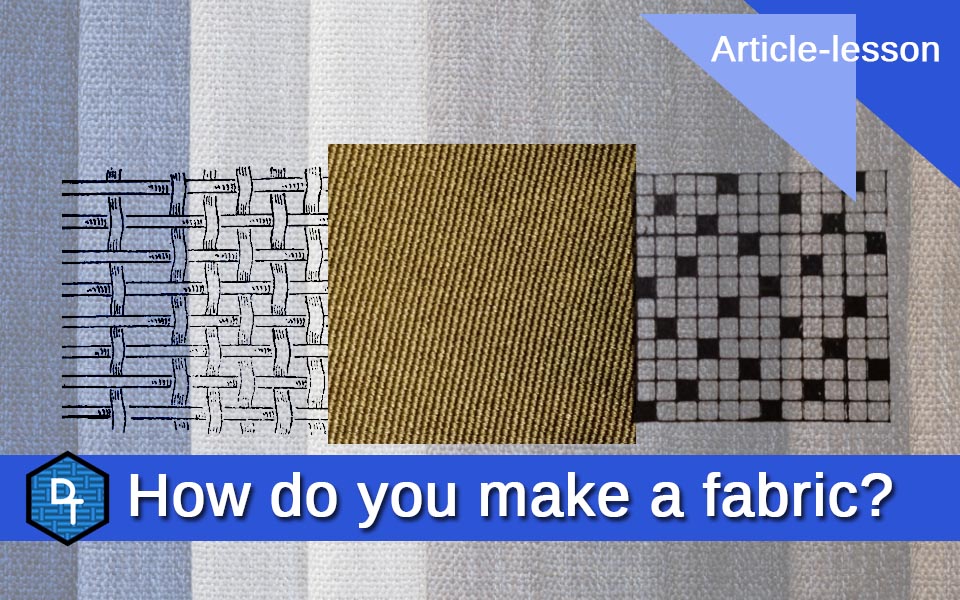
How do you make a fabric?
I must say that to answer in a truly complete at he question: how do you make a fabric, it would take a particularly in-depth study plan, as happens in specialized schools, given the vastness of the subject.
However, in this article I can definitely give you an introductory answer to make you understand some very useful basic concepts, and a first methodology to apply.
Let’s start right, from the basics: Normally to create a fabric, apart from all the various existing techniques, you can choose two paths.
The first path, is to give vent to your imagination and design a “new” type of fabric from scratch, with the characteristics you want. Let’s say that even if it is the most beautiful and artistic way, it needs to have a certain technical preparation, and also possibly a good experience. Therefore, for those who are just starting out, it is a methodology that is not feasible.
The second method, however, also used by experts in the industries, is also feasible by those who have no experience or a complete study of the subject. In practice it consists in the analysis of an existing fabric, and its reconstruction on paper, possibly reworking it in a slightly different way from the original, to create something new.
This method is practicable even at home and with very few tools.But in a business setting, which of the two methods is best?
There is no real rule really, it depends on the situation.
Let’s take the case where a customer wanted to reproduce an ancient fabric, of which there are no longer all the data to be able to make it directly, the only solution would be the analysis of that fabric and its reconstruction.On the other hand, if you wanted to create a fabric using your imagination, you could very well follow the first path, or a mix of the two, perhaps taking a cue from an existing fabric, and then making something totally different.
In this article, I’ll explain the basics of the second type of path, which on the one hand is “easier”, and on the other hand is the only way to go if you don’t already have a basic study, or experience.
But what does it mean to analyze a fabric?
Analyzing a fabric means finding out how the threads that make it up cross each other, and marking these data with a special coding on paper or by computer with specific software.
Basically, to perform this analysis, the simplest way possible and also the oldest in the true sense of the word, is to have a square paper, a pencil, a magnifying glass and logically the fabric to be analyzed.
But how does this work, or rather what do we have to do?The concept itself is simple: we need to observe how the vertical threads move relative to the horizontal threads, and create a mapping of these evolutions.
Let’s get started right now and see how it’s done in practice for to response of the question: How do you make a fabric?
We take a cloth that we are interested in analyzing, cutting out a small piece of it, large enough to contain the complete structure of the cloth, i.e. the minimum repeatable ratio.
To figure out what the minimum repeatable ratio can be, since we don’t really have numerical data to know, we need to exploit our most natural “skill”, which is the ability to observe.
Now, we take the piece of fabric, place it on a table, I recommend to illuminate well the surface possibly with a white light lamp, and begin to fray it.
Fraying means removing from the edges a certain number of threads, both vertical and horizontal, to allow you to see them well, and without them being intertwined with each other.
Below you can see an example: the fabric on the left is the starting fabric, the fabric on the right is the same after performing the operation just explained.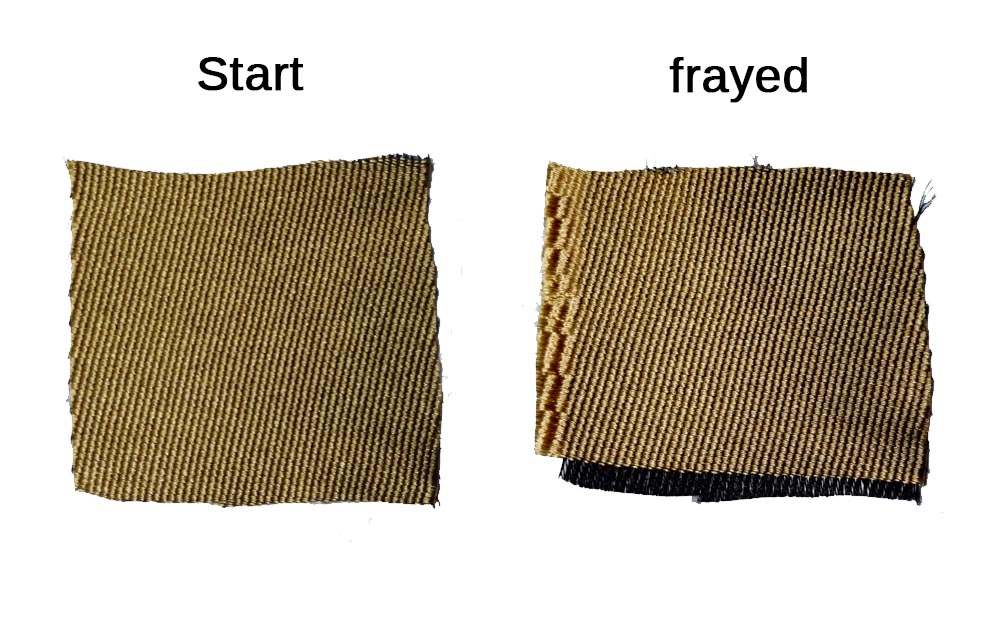
Now start with the first vertical thread (left side), and separate it a lot from the other threads, so you can see it very well.
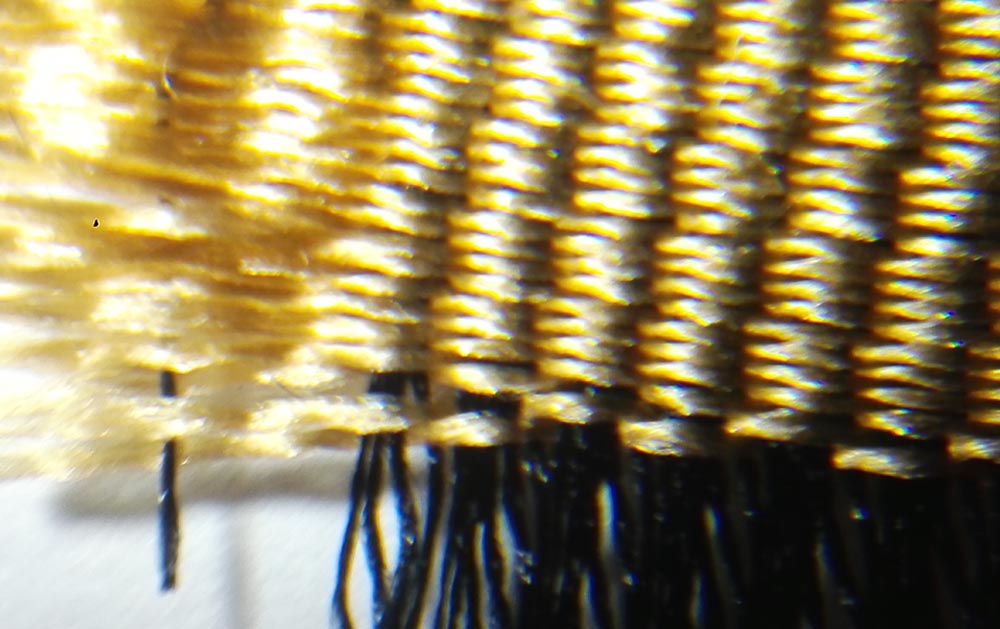
the photo was taken with a special magnifying glass Now you take a small lens, usually a special very small magnifying glass, made especially for this procedure (you can see it in the image below), and start to observe the evolution of the vertical thread compared to the horizontal one.
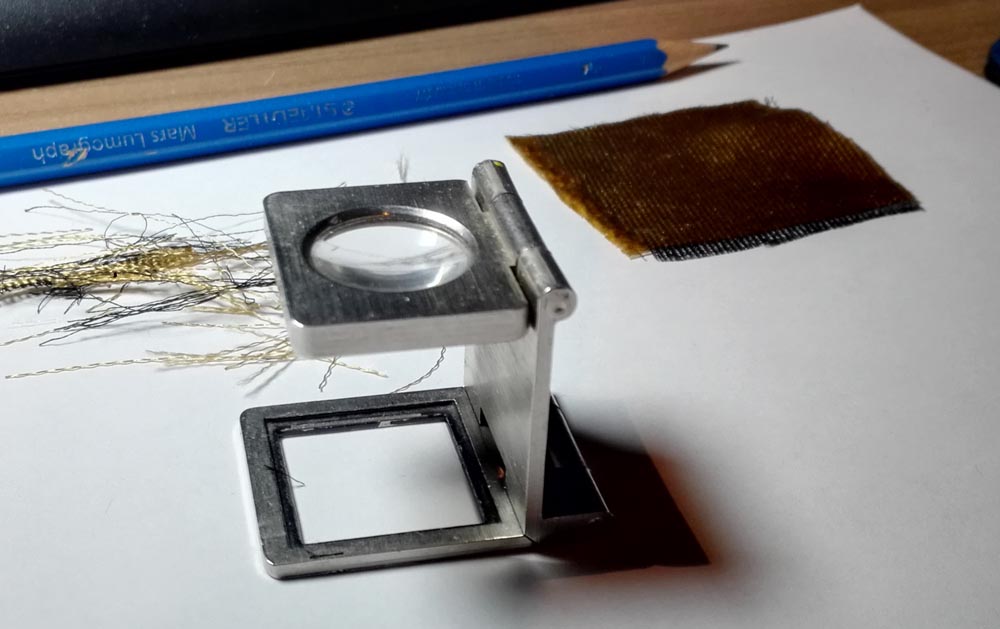
After a very first general observation, useful to understand a little bit the type of evolution, we really start with the real analysis phase.
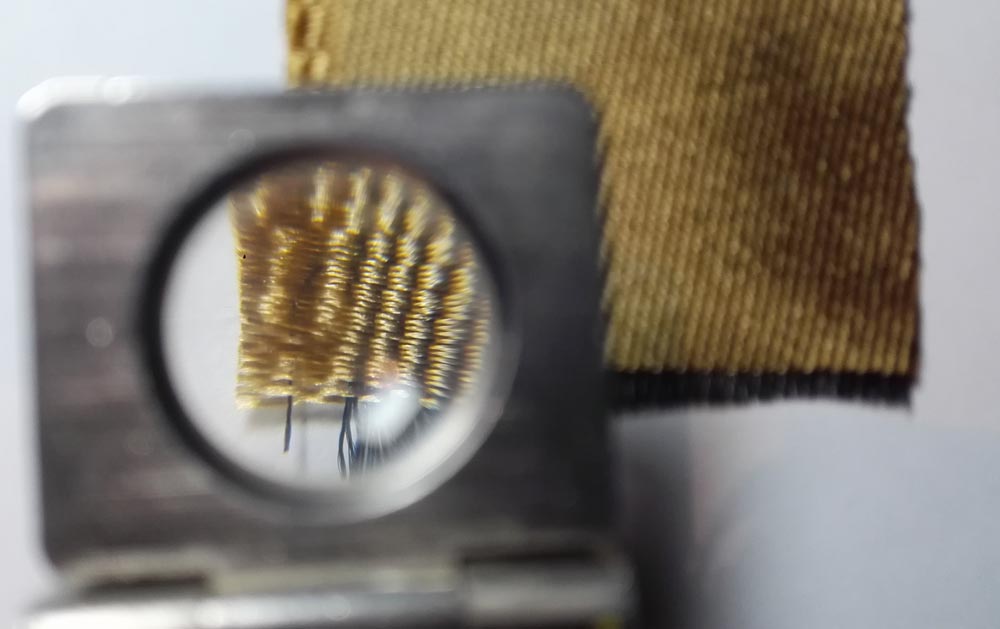
The method to use is as follows:
When the vertical thread (warp) passes over the horizontal thread (weft), color the first square on the sheet with a normal black pencil (you can choose the first square where you want it on the sheet). When you see that the vertical thread passes under the horizontal thread, leave the square empty, i.e. do not color it.
If you dont know well what are weft and warp, you can read this other article-lesson: What is a textile?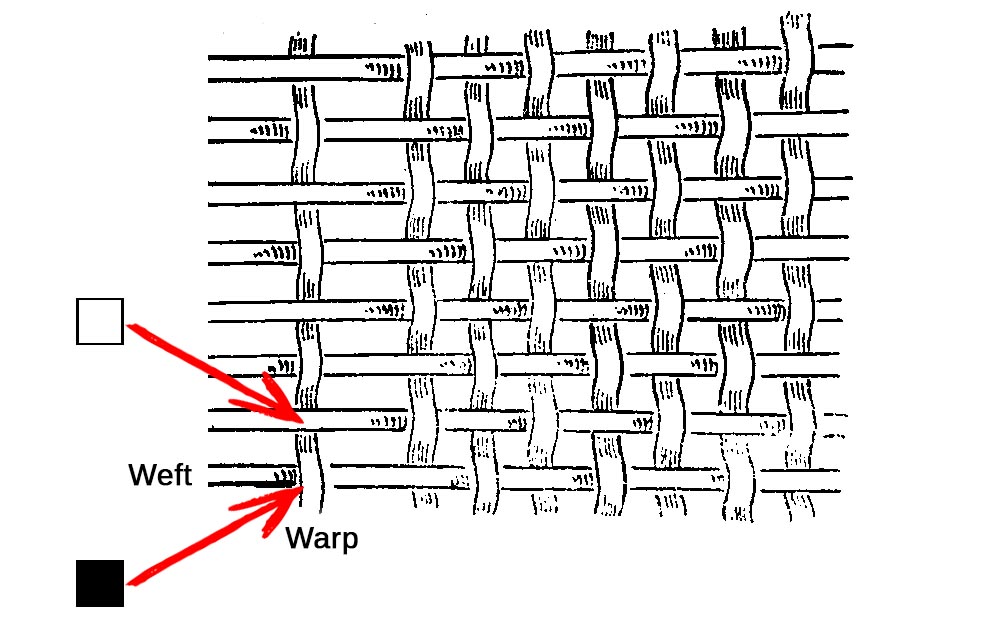
This procedure is to be repeated vertically for the first thread, until a perfect repeatability of the sequence of black and white squares is found.
The minimum possible value of repeatability is 2 squares vertically (2 wefts), up to very large numbers indeed.
As you will understand, this type of analysis requires a great deal of attention and patience, and in the case of particularly elaborate fabrics even a long time.
When you have discovered the first repeatable ratio of the first vertical thread above the various horizontal threads (i.e., wefts), you will have the entire ratio of the evolution of the first thread of the fabric, which will also indicate the total size of the entire structure in the Y direction of the entire fabric.
Now we must continue with the second vertical thread, moving to the right and removing the previous one that is no longer needed. At this point we repeat the entire analysis made on the first vertical thread, also on the second thread, and so on until we find a perfect repeatability of the evolutions also in the horizontal.
After finishing this procedure you will have found the entire weave structure of the fabric and have the basic data to be able to recreate it.
In the image below you can see a simple structure of a fabric reported on paper with the method described, (it is not the structure of the weave of the photo of the fabric seen above), where with the red box I have highlighted the repeatable ratio both as vertical threads (warp), and as horizontal threads (weft), which is 6 x 6.
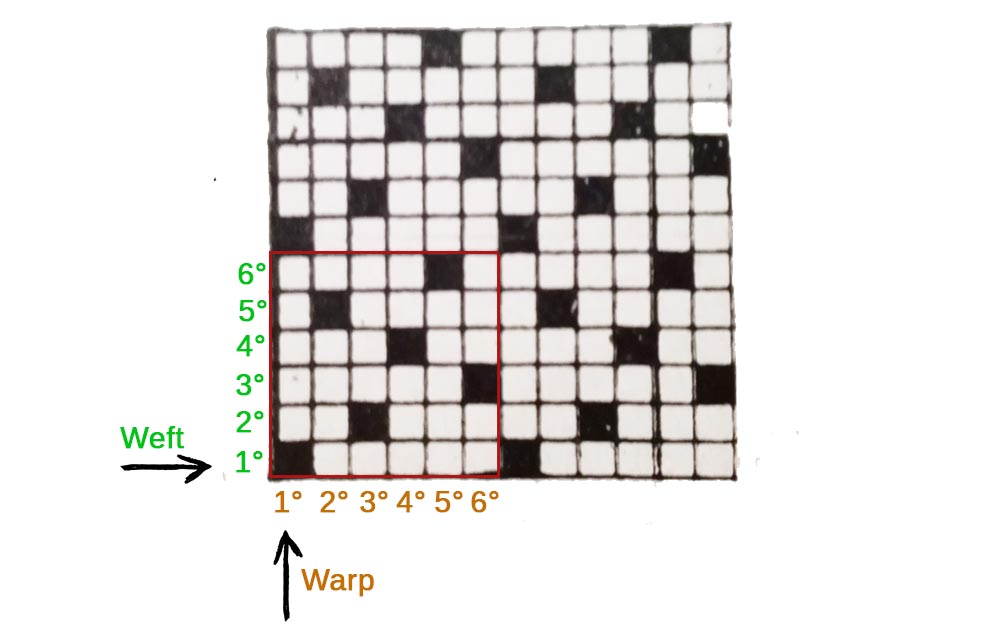
But how is it possible to use this checkered pattern, that is, this mapping of the evolutions of the threads on the wefts, to then recreate a real fabric?
On the theoretical side, i.e. still in the design phase there are further various phases, which do not concern this article-lesson, on the practical side, once all phases are finished you will have a complete coding, which can be used on the loom to weave the new fabric. But I will talk about this in future articles.
Perhaps, among the many questions that might now come to mind, there might be this one:
But which threads are vertical and which are horizontal? Since I can spin the fabric, and there doesn’t seem to be a default horizontal or vertical?The answer is more complex than you might think.
In order to recognize which is the true vertical side and which is the horizontal side, it is necessary to carry out a more in-depth analysis of the product type (i.e. the nature of the yarn) and of the technical type.
Thanks to these successive analyses, which can be done only after having studied the relevant methods, it will be possible to understand almost 100% which is the vertical side and which is the horizontal side of the fabric. Understanding this is fundamental, otherwise you won’t really be able to weave the fabric correctly!Let’s say that for a first phase of study and analysis, at the moment understanding which are really the vertical threads (warp), and the horizontal threads (weft), is not fundamental. But when you have to make a real fabric, it will definitely be, in order to avoid even real production disasters.
For this article-lesson, we’re done, and if you made it to the end of this article lesson: how do you make a fabric, thank you, and I hope I was helpful!
Now you know what the basic technique is, and the first one you study to start learning how to make fabric!See you soon!
If you think this article might be of interest to someone else you know, share it and you’ll be doing them a favor!